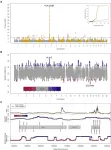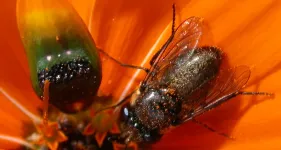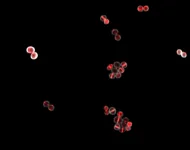(Press-News.org) When early Stone Age farmers first moved into Europe from the Near East about 8,000 years ago, they met and began mixing with the existing hunter-gatherer populations. Now genome-wide studies of hundreds of ancient genomes from this period show more hunter-gatherer ancestry in adaptive-immunity genes in the mixed population than would be expected by chance.
The findings, reported in Current Biology on March 23, suggest that mixing between the two groups resulted in mosaics of genetic variation that were acted upon by natural selection, a process through which all organisms, including humans, adapt and change over time.
The changes in immunity genes appeared in the major histocompatibility complex (MHC) region, a cluster of genes that code for surface proteins on cells and help our immune systems recognize pathogens. The researchers also detected more farmer ancestry in a gene called SLC24A5, which is involved in skin pigmentation.
“This tells us that these regions of the genome were experiencing natural selection,” said Tom Davy (@TomDavy_) of the Francis Crick Institute’s Ancient Genomics Laboratory in London. “The genetic variants predominantly carried by hunter-gatherers in the MHC region and by farmers in SLC25A5 increased in frequency in the descendant population.”
In recent years, the study of ancient genomes has allowed scientists to essentially travel back in time to trace the evolution of humans and other organisms. Whereas most ancient DNA studies have focused on archaeological questions, Davy and Pontus Skoglund at the Francis Crick Institute and Iain Mathieson and colleagues of the University of Pennsylvania realized that the increasing availability of standardized and shared ancient genome data now allows new questions about natural selection and human adaptation in prehistoric times.
They analyzed genome-wide DNA from 677 individuals spanning Mesolithic and Neolithic Europe. Their goal was to look for any ancestry deviations in the genomes of admixed individuals and to test whether those deviations appeared to be the result of natural selection, as opposed to random changes.
Their analysis found that a pigmentation-associated gene was the most overrepresented from the Neolithic local ancestry. In contrast, the mixed group retained more genes from the important MHC immunity locus from the hunter-gatherers. The findings could simply reflect the advantage of having more diversity in immune response, the researchers say. On the other hand, the MHC alleles from the hunter-gatherers might have been positively selected for because they facilitated greater survival and adaptation to pathogens in the Neolithic group.
Although other factors may have been at play, the findings highlight immune function as a prime target of natural selection in late-Stone-Age populations. The researchers say the increased immune representation from hunter-gatherers came as something of a surprise to them.
“A longstanding idea is that farming lifestyles drove immune adaptation due to denser settlements, new diets, and proximity to livestock,” Skoglund said. “When farming groups expanded from the Near East into Europe and mixed with local hunter-gatherers, the natural prediction would be that the farmers' immunity genes would be best adapted to the farming lifestyle and thus selected for. However, we see the opposite, that hunter-gatherer ancestry is enriched at the MHC immunity locus. This could, for example, be because the hunter-gatherers were already adapted to pathogens found in Europe, or it could be the result of natural selection favoring diversity in immunity genes.”
As for changes in pigmentation, earlier studies also had shown selection for reasons that aren’t fully understood. “One hypothesis is that lighter skin pigmentation allowed farmers to synthesize more vitamin D from ultraviolet radiation, while hunter-gatherers were able to obtain sufficient vitamin D from their diet,” Mathieson says.
Overall, the new study extends recent findings of adaptive admixture at the MHC region to selection in a Stone Age human population for the first time. The researchers say the discovery of greater diversity at the MHC locus opens new avenues for understanding the adaptations that came along with the shift to an agricultural lifestyle, which the researchers note was a fundamental transition that happened worldwide in human history.
“This study revealed natural selection during the agricultural transition in one region of the world, Europe, but other regions are not well understood,” Skoglund said. “Future ancient-DNA studies will also be able to address to what extent immunity was a key target also in other periods of environmental and lifestyle change during human evolution.”
####
This work was supported by the NIGMS; the EMBO Young Investigator Programme; the Vallee Foundation; the European Research Council; the Wellcome Trust; and Francis Crick Institute core funding from Cancer Research UK, the UK Medical Research Council, and the Wellcome Trust.
Current Biology, Davy et al.: “Hunter-gatherer admixture facilitated natural selection in Neolithic European farmers” https://www.cell.com/current-biology/fulltext/S0960-9822(23)00189-6 DOI: 10.1016/j.cub.2023.02.049
Current Biology (@CurrentBiology), published by Cell Press, is a bimonthly journal that features papers across all areas of biology. Current Biology strives to foster communication across fields of biology, both by publishing important findings of general interest and through highly accessible front matter for non-specialists. Visit http://www.cell.com/current-biology. To receive Cell Press media alerts, contact press@cell.com.
END
A male fly approaches a flower, lands on top of what he thinks is a female fly, and jiggles around. He’s trying to mate, but it isn’t quite working. He has another go. Eventually he gives up and buzzes off, unsuccessful. The plant, meanwhile, has got what it wanted: pollen.
A South African daisy, Gorteria diffusa, is the only daisy known to make such a complicated structure resembling a female fly on its petals. The mechanism behind this convincing three-dimensional deception, complete ...
Francis Crick Institute press release
Under strict embargo: 15:00hrs GMT 23 March 2023
Peer reviewed
Observational study
People
Research from the Francis Crick Institute published today in Current Biology has revealed that diversity in genes coding for immunity may have facilitated adaptation to farming lifestyles in prehistoric periods.
Researchers at the Ancient Genomics Laboratory at the Crick studied available genome-wide DNA from 677 individuals dating to Stone Age Europe, spanning the movement of Neolithic farmers from the Near East into Europe about 8000 years ago, where they mixed with Mesolithic hunter-gatherers already in Europe.
They were interested in whether ...
Being vaccinated against Covid halves people’s risk of developing long Covid, according to new research from the University of East Anglia.
Long Covid still affects some two million people in the UK, and new research published today reveals the risk factors associated with developing the condition.
Overweight people, women, smokers and those over the age of 40 are also more likely to suffer from long Covid according to the study - which includes more than 860,000 patients and is thought to be the largest of its kind.
The study also finds that co-morbidities such as asthma, COPD, Type 2 Diabetes, coronary heart disease, immunosuppression, anxiety ...
About The Study: This systematic review and meta-analysis of 41 studies including 860,000 patients found that certain demographic characteristics (e.g., age and sex), comorbidities, and severe COVID-19 were associated with an increased risk of post−COVID-19 condition (PCC; also known as long COVID), whereas vaccination had a protective role against developing PCC sequelae. These findings may enable a better understanding of who may develop PCC and provide additional evidence for the benefits of vaccination.
Authors: Vassilios ...
About The Study: This cohort study found that in people with SARS-CoV-2 infection who had at least one risk factor for progression to severe disease, treatment with nirmatrelvir within five days of a positive SARS-CoV-2 test result was associated with reduced risk of post−COVID-19 condition (also known as long COVID) across the risk spectrum in this cohort and regardless of vaccination status and history of prior infection. The totality of the findings suggests that treatment with nirmatrelvir ...
About The Study: This case control study found that for female individuals, the loss of abortion rights was associated with a 10% increase in prevalence of mental distress relative to the mean over the three months after the Supreme Court of the U.S. decision. Restricting legal abortion access may be associated with disproportionate outcomes among individuals of lower socioeconomic status and in medically underserved areas, who may experience greater economic and mental health burdens of having unwanted pregnancies due to increased travel costs of obtaining abortions.
Authors: Muzhe Yang, Ph.D., of Lehigh University in Bethlehem, ...
BOSTON – New research led by investigators at Massachusetts General Hospital (MGH), a founding member of Mass General Brigham (MGB), found that males but not females born to mothers with SARS‐CoV‐2 infection during pregnancy were more likely to receive a neurodevelopmental diagnosis in the first 12 months after delivery. The findings are published in JAMA Network Open.
Previous studies have found associations between other infections during pregnancy and increased risk of neurodevelopmental disorders in children, such as autism spectrum disorder, but it’s unclear if such a link exists with SARS‐CoV‐2 infection during pregnancy. To investigate, ...
MIAMI, FLORIDA (EMBARGOED UNTIL THURSDAY, MARCH 23, 2023, AT 11 A.M. ET) – Treatment outcomes for patients with malignant pleural mesothelioma, a rare cancer commonly known as mesothelioma, are often affected by social determinants of health and overall survival rates could be improved by addressing these health disparities and improving access to specialized care.
That’s the key takeaway from new research published March 23 by investigators at the Sylvester Comprehensive Cancer Center at the University of Miami Miller School of Medicine and collaborators, whose study appears in the journal JAMA Network Open.
“We found that mesothelioma patients who ...
FOR IMMEDIATE RELEASE
Research from Johns Hopkins Kimmel Cancer Center experts revealed a type of RNA, previously considered to be “junk,” that may help doctors distinguish and treat a subgroup of patients with medulloblastoma.
Medulloblastoma is the most common malignant brain tumor in children, accounting for about 20% of all pediatric brain cancers. Four groups of medulloblastomas have been identified, and one is named sonic hedgehog (SHH) because of the spiky, hedgehog-like appearance of fruit flies ...
We still do not understand exactly how antibiotics kill bacteria. However, this understanding is necessary if we want to develop new antibiotics. And that is precisely what is urgently needed, because bacteria are currently showing more and more resistance to existing antibiotics. Therefore, researchers from the University Hospital Bonn (UKB) and the University of Bonn used high-performance microscopes to observe the effect of different antibiotics on the cell division of Staphylococcus aureus. They found that the biosynthesis of peptidoglycan, core component of the bacterial cell wall, is the driving force during the entire process of cell division. In ...





